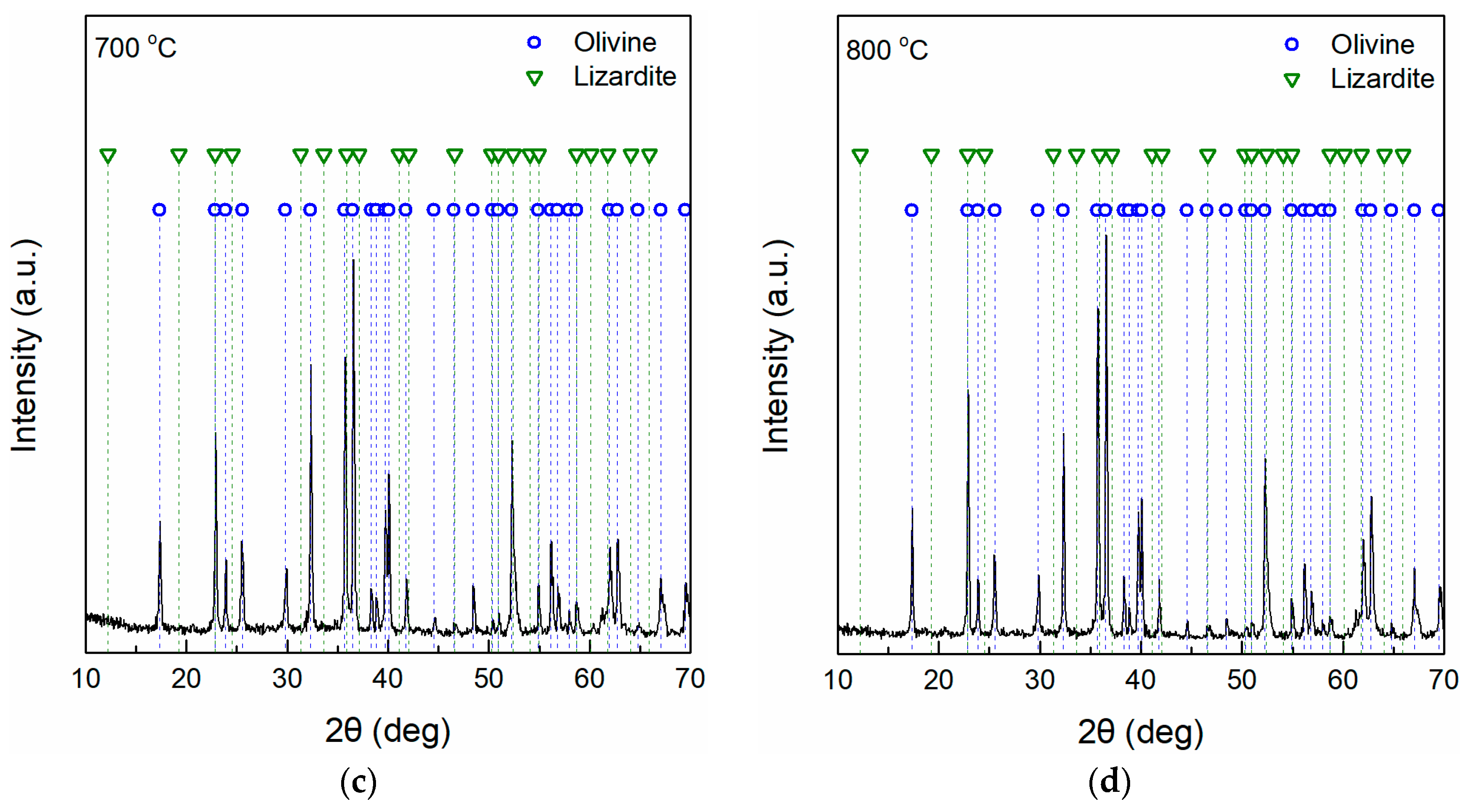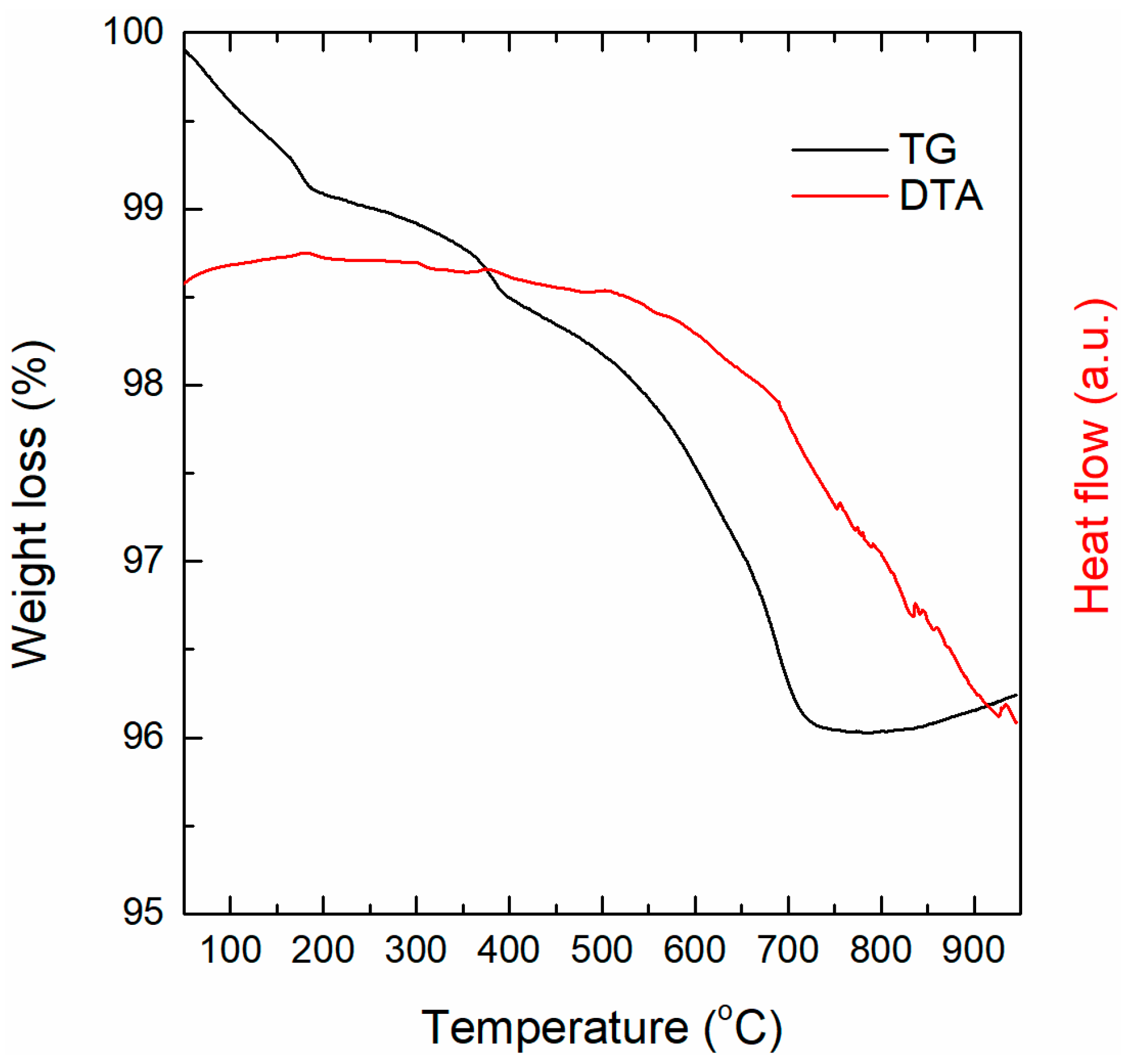1. Introduction
Chromium is included in the list of so-called strategic metals due to its applications but also its scarcity, as its only source is the mineral chromite. Chromite is mainly used in the production of stainless steel and various kinds of alloy steel in the form of ferroalloy, which has the advantages of high hardness, wear resistance, heat resistance and corrosion resistance [
1]. As an ore, it is mined from ophiolite complexes, and it is found in the lower layers of these, between basic and ultrabasic igneous rocks. Therefore, in most cases, the application of an ore enrichment process is necessary, and it concerns its separation from these rocks [
2]. The aim is to increase the Cr
2O
3 content of the ore so that it meets the demand specifications and becomes commercially exploitable.
Therefore, during the mining and beneficiation processes applied to chromite, significant amounts of solid waste materials are usually produced. These ultrabasic rocks are mainly various structures of olivine and serpentine (i.e., hydrous structures of olivine). Although the main product of the respective enrichment process (mineral dressing) is the chromite ore, the ultrabasic rocks can be also considered as potentially useful by-products, rather than waste [
3]. Their utilization in other processes complies with the principles of the circular economy, as applied in mining activities, and it has already attracted the interest of the scientific community.
The aim of this study was initially the physicochemical characterization of these wastes and, subsequently, an increase in the olivine/serpentine ratio by the application of proper thermal treatment in order to be able to find alternative applications, e.g., the neutralization of acidic mine effluents or as an additional material to ceramics, aiming at enhanced properties. However, the presence of a large percentage of serpentine may reduce the performance when attempting to apply the ultrabasic rocks in these alternative applications. According to the literature, the application of thermal treatment is possible to limit the presence of serpentine, making it more attractive/suitable for use in the aforementioned (or other) potential applications [
4].
2. Materials and Methods
This study was carried out with samples collected from the Vourinos area in the Kozani region (Western Macedonia, Greece), where chromite mines and the enrichment mineral plant are located. Initially, the samples were ground by a ball mill, homogenized and sieved (<100 μm). Afterwards, the homogenized sample was placed in a porcelain capsule and thermally treated (temperatures 600 °C, 700 °C and 800 °C) using a WITEG Muffle Furnace, model FHX-05.
The main structural phases were identified by X-ray diffractometry (XRD), using a water-cooled Rigaku Ultima+ diffractometer with CuKa radiation, a step size of 0.05° and a step time of 3 s, operating at 40 kV and 30 mA. The diffraction patterns were compared to the respective Powder Diffraction Files (PDF) database [
5]. The application of thermo-gravimetric analysis (TG-DTA) to a sample can provide information about the processes that take place in a wide temperature range. Data were collected by a water-cooled Perkin-Elmer STA 6000 instrument in the range 50–900 °C and by applying a heating rate of 20 °C/min, under air flow.
A field emission-scanning electron microscope (FE-SEM Quanta 200, Berkhamsted, UK), equipped with an EDAX energy-dispersive X-ray spectroscopy analyzer, was used to determine the distribution of elements in the structure of the examined samples.
3. Results
3.1. Structural and Chemical Analysis
Ultrabasic rocks are mainly various structures of olivine and serpentine. Their general formulas are (Mg,Fe)
2SiO
4 and (Mg,Fe)
3Si
2O
5(OH)
4, respectively. In detail, serpentine is a hydrous structure of olivine that may contain magnesium, silicon and iron [
6]. According to
Figure 1a, both structures were obtained in the initial homogenized sample. In addition, it was identified that the dominant phase of serpentine is lizardite, a mineral that is included in the serpentine subgroup. Its general formula is Mg
3Si
2O
5(OH)
4, i.e., iron is not involved in the formation of its structure.
Energy-dispersive X-ray spectroscopy (EDAX) is a microanalysis technique used for the identification of the elements present in a sample. This technique also quantifies the elemental composition of the sample. The relevant results are presented in
Table 1, from which the presence of the metals that form the previously mentioned structures of olivine and serpentine can be confirmed. Their resulting percentage content did not correspond to their ratios according to their chemical formulas; therefore, the presence of their oxides was not excluded. The ratio Si/(Si+Mg) of the serpentine group was in the range 0.4–0.6, while, in the initial sample, the corresponding value was calculated at 0.42 [
7]. On the other hand, the ratio Mg/(Mg+Fe) of olivine was in the range of 0.65–0.95 and the sample’s corresponding value was calculated at 0.88.
3.2. Thermal Behavior
The processes that took place during the thermal treatment of the initial sample were studied using the TG/DTA diagram. According to
Figure 2, significant structural changes were obtained in the serpentinized olivine at distinct temperature ranges. Up to 180 °C, the physiosorbed water molecules were removed, indicted by a slight endothermic peak. The weight loss in the range 180–400 °C was attributed to crystalline water release and dehydroxylation, also an endothermic process [
8]. The main dehydroxylation took place in the range 400–700 °C, since the highest mass loss was observed here. The decomposition of the serpentine crystal structure followed the aforementioned process, indicated by the wide exothermic peak [
9].
3.3. Structural Properties
As mentioned before, the initial sample consisted of olivine and serpentine, with the lizardite being the main structure (
Figure 1a). According to the XRD diagrams, the sample’s thermal treatment at 600 °C limited the lizardite content as its corresponding peaks presented lower intensity (
Figure 1b). At 700 °C (
Figure 1c), peaks that were attributed to lizardite were eliminated and those that overlapped were excluded, while an even higher temperature of 800 °C (
Figure 1d) presented no effect on the olivine structure.
4. Conclusions
In this work, a serpentinized olivine sample collected from the field, considered as waste from the mining and enrichment processes of chromite, was studied. The high serpentine content decreases the quality of olivine, a material that has great potential for use in other applications. Thermal treatment at 700 °C proved to be capable of decomposing serpentine, which was transformed into olivine. The ratio Si/(Si+Mg) of the serpentine group dropped below the range 0.4–0.6, i.e., the calculated value was 3.9, while the ratio Mg/(Mg+Fe) of olivine was retained in the range of 0.65–0.95. The TG/DTA and XRD diagrams were in good agreement regarding the optimal temperature.
Author Contributions
Conceptualization, Ε.Κ., E.P. and A.Z.; methodology, E.K.; software, E.K.; validation, Ε.Κ., E.P. and A.Z.; formal analysis, E.P.; investigation, E.K.; resources, A.Z.; data curation, E.K.; writing—original draft preparation, E.K.; writing—review and editing, Ε.Κ., E.P. and A.Z.; visualization, E.K.; supervision, A.Z.; project administration, E.P.; funding acquisition, A.Z. All authors have read and agreed to the published version of the manuscript.
Funding
This research has been co-financed by the European Regional Development Fund of the European Union and Greek national funds through the Operational Program Competitiveness, Entrepreneurship and Innovation, under the call RESEARCH—CREATE—INNOVATE (project code: T2EDK-02206).
Institutional Review Board Statement
Not applicable.
Informed Consent Statement
Not applicable.
Data Availability Statement
Data are contained within the article.
Conflicts of Interest
The authors declare no conflict of interest.
References
- Nayak, S.; Rangabhashiyam, S.; Balasubramanian, P.; Kale, P. A review of chromite mining in Sukinda Valley of India: Impact and potential remediation measures. Int. J. Phytoremediation 2020, 22, 804–818. [Google Scholar] [CrossRef] [PubMed]
- Murthy, Y.R.; Tripathy, S.K.; Kumar, C.R. Chrome ore beneficiation challenges & opportunities—A review. Miner. Eng. 2011, 24, 375–380. [Google Scholar]
- Cavallo, A. Serpentinitic waste materials from the dimension stone industry: Characterization, possible reuses and critical issues. Resour. Policy 2018, 59, 17–23. [Google Scholar] [CrossRef]
- Acar, İ. Sintering properties of olivine and its utilization potential as a refractory raw material: Mineralogical and microstructural investigations. Ceram. Int. 2020, 46, 28025–28034. [Google Scholar] [CrossRef]
- Joint Center for Powder Diffraction Studies (JCPDS). Powder Diffraction File; International Centre for Diffraction Data: Newtown Square, PA, USA, 2004. [Google Scholar]
- Tutolo, B.M.; Evans, B.W.; Kuehner, S.M. Serpentine–Hisingerite solid solution in altered ferroan peridotite and Olivine Gabbro. Minerals 2019, 9, 47. [Google Scholar] [CrossRef]
- Villegas-Bolaños, P.A.; Gallego, J.A.; Dorkis, L.; Márquez, M.A. Glycerol valorization using Colombian olivine as a catalyst. Heliyon 2023, 9, 15561. [Google Scholar] [CrossRef] [PubMed]
- Emrullahoglu Abi, C.B.; Gürel, S.B.; Kılınç, D.; Emrullahoglu, Ö.F. Production of forsterite from serpentine—Effects of magnesium chloride hexahydrate addition. Adv. Powder Technol. 2015, 26, 947–953. [Google Scholar] [CrossRef]
- Hršak, D.; Sučik, G.; Lazić, L. The thermophysical properties of serpentinite. Metalurgija 2008, 47, 29–31. [Google Scholar]
| Disclaimer/Publisher’s Note: The statements, opinions and data contained in all publications are solely those of the individual author(s) and contributor(s) and not of MDPI and/or the editor(s). MDPI and/or the editor(s) disclaim responsibility for any injury to people or property resulting from any ideas, methods, instructions or products referred to in the content. |
© 2023 by the authors. Licensee MDPI, Basel, Switzerland. This article is an open access article distributed under the terms and conditions of the Creative Commons Attribution (CC BY) license (https://creativecommons.org/licenses/by/4.0/).










